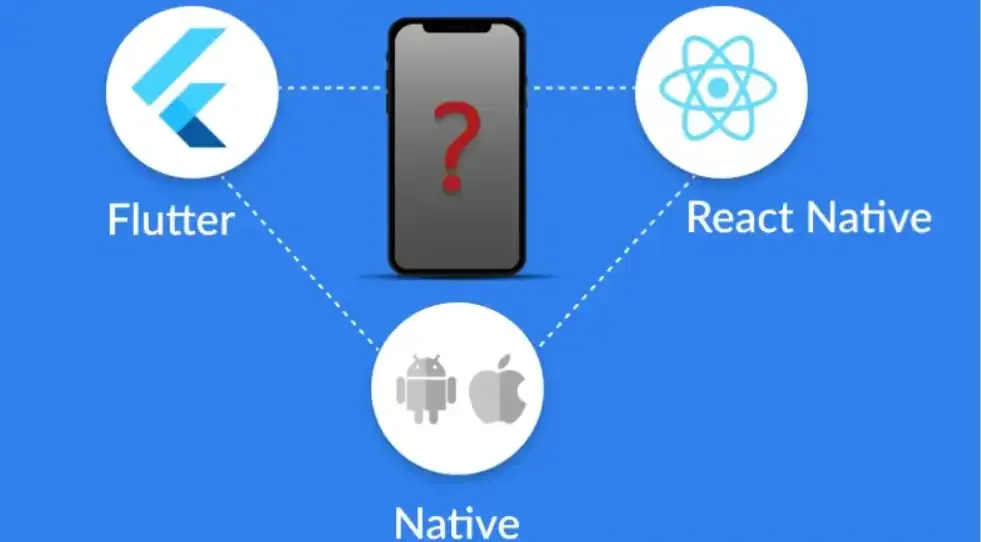Mixed Applications: Native Development with Java/Kotlin and the symphony of React Native and Flutter
- #Flutter
- #Kotlin
- #Java
Joining Forces: A Detailed Exploration of how mixed applications blending native code and features in hybrid languages or cross platforms operate in synchrony.
When delving into the realm of mobile application development, we frequently encounter the distinctive features of platforms (Android and iOS), along with the decision-making process between native and hybrid development for a given application. Nevertheless, a pertinent question emerges: what, indeed, constitutes the fundamental difference between these approaches?
Let’s start by detailing the meanings of each one.
Native applications

Native mobile development involves creating applications specific to a particular platform, such as Android or iOS, using the programming languages and tools native to each system. For example, native development for Android may involve using Java or Kotlin, while for iOS, Swift or Objective-C are commonly employed.
Advantages of Native Mobile Development:
- Superior Performance: Native applications generally offer more efficient performance as they are optimized to take full advantage of the platform’s features and functionalities.
- Seamless UI Integration: Native development allows for more fluid integration with the platform-specific UI, resulting in a more consistent and intuitive experience.
- Rapid Support for New Platform Updates: Updates and new features released by the platform are quickly incorporated into native applications, ensuring ongoing compatibility.
- Full Access to Device Features: Developers have full access to all device features, such as camera, GPS and sensors, providing a richer user experience.
Disadvantages of Native Mobile Development:
- Development Cost and Time: Developing for each platform separately can be more expensive and time-consuming, as it requires teams specialized in each technology.
- Dual Maintenance: Maintaining two sets of code for different platforms can be challenging and require more maintenance effort.
- Less Code Reuse: Each platform requires specific codes, resulting in fewer opportunities for code reuse between different versions of the application.
- Learning Curve for New Developers: Developers may need to learn different languages and development environments to work on multiple platforms.
Hybrid and cross platforms applications

Hybrid mobile apps combine elements of native and web development. They are built using standard web technologies such as HTML, CSS and JavaScript and are encapsulated in a native container that allows them to run on different platforms. Frameworks like React Native, Flutter, and Ionic are popular examples of tools used for hybrid mobile app development.
Advantages of Hybrid Mobile Applications:
- Reduced Development Cost and Time: Developing a single code for multiple platforms reduces time and costs compared to separate native development.
- Simplified Maintenance: Maintaining one code base makes it easier to implement fixes and updates on both platforms simultaneously.
- Efficient Code Reuse: Much of the code can be shared between versions for different platforms, increasing development efficiency.
- Shorter Learning Curve: Web developers can use their existing HTML, CSS, and JavaScript skills, easing the transition to hybrid mobile development.
Disadvantages of Hybrid Mobile Applications:
- Lower Performance: Compared to native apps, hybrid apps can exhibit lower performance, especially in processing-intensive tasks.
- Limited Access to Native Features: Although hybrid frameworks provide access to some native features, there may be limitations compared to pure native development.
- Dependency on Framework Updates: Dependency on specific frameworks can result in compatibility challenges and updates that can affect the functioning of the application.
- Less Integrated User Interface: Despite efforts to replicate the native experience, the user interface may not be as integrated and fluid as in native applications.
What about Mixed Applications?

In mixed applications, the cross-platform approach plays a key role. Cross-platform development refers to the practice of creating applications that can run on multiple platforms, such as Android and iOS, using a single code base.
To implement the hybrid part of mixed applications, many organizations turn to cross-platform development frameworks. Notable examples include React Native, Flutter, and Xamarin. These frameworks allow developers to write code once and use it on both platforms.
Component Reuse: With cross-platform development, developers can reuse UI components and business logic across multiple platforms. This significantly contributes to development efficiency and user experience consistency.
Native Code Integration: Cross-platform code is often integrated with specific parts of the platform through native APIs and bridges. This allows critical functionalities, which require high performance or full access to native resources, to be implemented natively.
Advantages of Cross-Platform Development in Mixed Applications:
- Time and Resource Savings: Developing for multiple platforms with a single code base saves time and resources compared to separate native development.
- User Experience Consistency: Using cross-platform frameworks helps ensure a more consistent user experience, as a significant portion of the code is shared across platforms.
- Simultaneous Updates: Updates and fixes can be implemented simultaneously on both platforms, facilitating maintenance.
Challenges of Cross-Platform Development in Mixed Applications:
Performance Challenges: Despite advancements, cross-platform applications can still face performance challenges compared to native applications, especially in processing-intensive tasks.
Limitations on Access to Native Resources: Some native resources may not be fully accessible through cross-platform frameworks, requiring specific solutions for each platform.
Careful planning is the first step

In conclusion, the decision between native, hybrid or mixed mobile development requires careful analysis, taking into account the specifics of business rules and long-term plans for the application in question. Aspects such as costs and learning curve for each approach play a crucial role in decision making.
Furthermore, it is essential to stay up to date with trends and innovations presented by the main players in the technology sector, such as Google, Apple, Meta and others. The dynamic nature of mobile development means keeping an eye on releases and updates, ensuring that applications are aligned with the latest technologies and offer an up-to-date experience to users.
This way, by balancing the specific needs of the project with the opportunities and challenges offered by each approach, developers can make informed decisions, providing efficient and successful mobile solutions in today’s constantly evolving technological landscape.
This technical article is a republication from another platform that I used before













